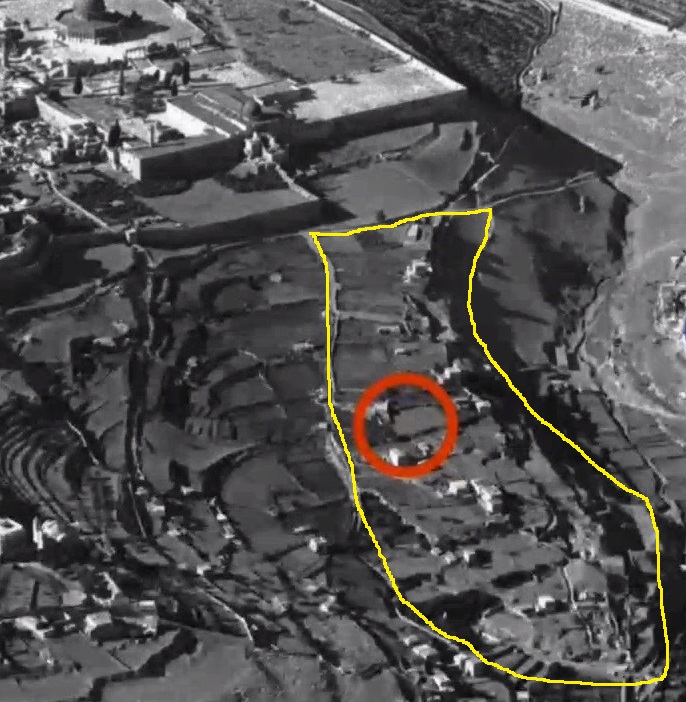
Courtesy of Bob Cornuke
In order to understand and know where the Temple of the Lord was located, let the Scriptures speak. (King James Version - all emphasis by the author)
First, the Lord stated that He would chose a place for His name:
David’s men captured the fortified Jebusite stronghold. He lived there and called it the City of David.
The Original City of David
Jerusalem, or the City of David, at the time of David was the small peninsula-shaped piece of land south of the traditional Temple Mount. It was composed of about twelve acres. It was not the much expanded Jerusalem of today.
The photo below shows the “peninsula” of the City of David. The square area above it is what is known as the Temple Mount. I refer to this as the legendary or traditional Temple Mount because there are few, if any, facts identifying it as the location of the Temple of Solomon, Zerubbabel or Herod.

This aerial photo of the City of David was discovered by Bob Cornuke. It confirms the prophecy of Micah that Zion would be as a plowed field.
"Therefore shall Zion for your sake be plowed as a field, and Jerusalem shall become heaps..." Micah 3:12Micah's prophecy was confirmed in Jeremiah 26:18.
When King David sinned by taking a census of his fighting men, the Lord sent an angel:
“And God sent an angel unto Jerusalem to destroy it: . . . And the angel of the LORD stood by the threshing floor of Ornan the Jebusite. And David lifted up his eyes, and saw the angel of the LORD stand between the earth and the heaven, having a drawn sword in his hand stretched out over Jerusalem.” - I Chronicles 21:15-16The angel of the Lord was standing over Jerusalem, which at that time was the City of David. King David bought that property from Ornan for six hundred shekels of gold by weight. (I Chronicles 21:24-26) Later, Solomon built the House of the Lord at the place that David had prepared, in the threshing floor of Ornan the Jebusite. (II Chronicles 3:1) Solomon built the Temple of God in the Jerusalem of his day, in what we know as the City of David.
Solomon also built the wall around the Jerusalem of his day. (I Kings 9:15) Flavius Josephus, the First Century Jewish historian, describes this place as the hill which Solomon encompassed with a wall. (Flavius Josephus, Antiquities of the Jews, Book XV, Chapter 11, Paragraph 3) Josephus continues; “This hill was walled all round, . . . in the midst of which was the Temple itself.” – ibid. Josephus clearly states that the Temple was in the center of this walled compound in the City of David. Please note that Flavius Josephus was an eye witness to the Temple, its location, and its destruction. He was not speculating.
More importantly than Josephus, Holy Scripture tells us that the Temple was in the center of the City of David. Ezekiel chapters ten and eleven describe the Glory of the Lord departing the Temple about 600 B.C. After the Glory paused over the eastern threshold of the Temple (Ezekiel 10:19), it then “went up from the midst of the city, and stood upon the mountain which is on the east side of the city.” (Ezekiel 11:23) The mountain to the east is the Mount of Olives. This is the point where the Lord will set foot when He returns. (Zechariah 14:4)
The traditional Temple Mount cannot be considered the center of the city of Jerusalem at the time of King Solomon. At the very best, it would be considered the north portion of Jerusalem. The area north of the traditional Temple Mount was not settled until the Second Temple period. Therefore, the legendary Temple Mount was on the outskirts of the city, not in its center. This area is known as the Bezetha and is referred to by Josephus as the “New City.” It did not become part of Jerusalem until it was walled in by King Agrippa (41-44 A.D.), after the time of the Lord Jesus. When Ezekiel saw the Glory of the Lord rise up from the midst of the city, it was the City of David.
Josephus and historians before him recorded the fact that the Temple of God was in the center of the City of David, which is south of the traditional Temple Mount. The Jewish Mishnah contains an injunction against using the Temple as a short cut between the two parts of the city. It is not logical that the legendary Temple Mount, north of the City of David, was a shortcut.
Nehemiah chapter three tells of the rebuilding of the walls of Jerusalem after the Babylonian destruction. Nehemiah 3:15-16 specifically mention geographic features (e.g. – the Pool of Siloam) that are only located in the City of David. Nehemiah 12:36-37 confirms that the Jerusalem of the time following the Babylonian Captivity was the City of David.
Scripture and the historian Flavius Josephus tell us that the Temple was in the City of David. However, two hundred years ago, the location of the City of David was not known with certainty. It had been lost. Then Hezekiah’s tunnel was found in 1838. This is the tunnel King Hezekiah had prepared in anticipation of an attack by the Assyrians. (II Chronicles 32:30) The tunnel runs from the Gihon Spring to the Siloam Pool at the foot of the City of David. Today, archaeologists have found an inscription in this tunnel beneath the City of David stating that it was built at the command of King Hezekiah.
Now we know the location of the City of David. We know that it is also known as Mount Zion. We know that Zion is the place the Lord God chose to place His name.
The Tomb of King David
Currently, the Tomb of King David is said to be on the Western Hill of Jerusalem in a 1,000 year old building. But King David died 3,000 years ago. And Scripture places the Tomb of David within the original boundaries of the City of David. Nehemiah chapter three describes the rebuilding of the walls of the City of David. As he records the repairs section by section, in Nehemiah 3:15 he notes the Pool of Siloam and the steps leading down from the City of David, both of which are at the southern end of the city. Next, in Nehemiah 3:16, Nehemiah records the repairs done near the Tomb of David, in the City of David.
Some believe that the circuitous route of Hezekiah’s Tunnel was caused by efforts of the diggers to avoid the Tomb of David. The location of the tomb was known as late as the time of King Herod, who raided the tomb and took away “furniture of gold, and those precious goods that were laid up there.” He made a second attempt, but this time fire issued from the tomb and killed two of Herod’s bodyguards. (Josephus, Jewish Antiquities, Book 16, Chapter 7, Paragraph 1) Herod made no further attempts at tomb-raiding.
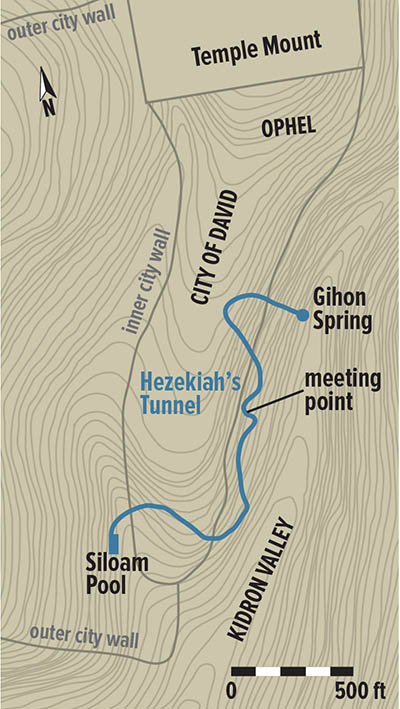
Just as the City of David had been lost, the Tomb of King David is another example of misplaced and lost structures and landmarks in Jerusalem.
The Gihon Spring
Large amounts of water were required for Temple worship. There was much blood, from the many sacrifices, that needed to be washed away. When King Solomon dedicated the Temple, an inconceivable number of sheep and oxen were sacrificed. (I Kings 8:5) Also, the great bronze Sea, which held 3,000 measures (baths) of water, required almost 18,000 gallons of water to be filled. The priests used this water to cleanse themselves before entering the Temple. This water was changed daily per Alfred Edersheim. (The Temple, Alfred Edersheim, p. 45)
Some explain the water as being provided by the Gibeonites, (Joshua 9:27) but this occurred during the time of the Tabernacle. Others believe the “Pools of Solomon,” about five miles from Jerusalem, were the source of water for the Temple via aqueduct. Archaeologists say that these pools were so named long after the time of Solomon (c. 960 B.C.). According to archaeologists, the pools and aqueducts date to the Second Temple period (586 B.C.-70 A.D.), long after the Temple of Solomon. The Second Temple was built on the same site as Solomon’s Temple, and the water did not come from the "Pools of Solomon."
The Letter of Aristeas is of Greek origin and was written in the Third Century B.C. Josephus gave this letter great credibility. Aristeas described the Temple’s having “an inexhaustible supply of water, because an abundant spring gushes up from within the temple area.” (Letter of Aristeas to Philocrates, Pseudepigrapha of the Old Testament, Letter of Aristeas, R. H. Charles, Volume 2, page 83, verse 89)
The root of “Gihon” means to burst forth or gush. The Gihon Spring is a siphon spring, which means that it periodically gushes forth water, much like the Old Faithful geyser of Yellowstone National Park. There is no natural source of water on or around the legendary Temple Mount. Can you imagine carrying 18,000 gallons of water for the great bronze sea up to the traditional Temple Mount from the Gihon Spring on a daily basis? This amounts to about seventy-five tons of water. That was not practical.
The Jebusites had built a city where there was a source of water, the Gihon Spring. David’s men captured the city, and renamed it the City of David. The City of David is located over the Gihon Spring. The Gihon Spring and Hezekiah’s Tunnel are in the City of David, and Solomon built the Temple at that location.
The Tower of Antonia
We know where the City of David is located. And, again, the Bible and history tell us that the Temple was located in the City of David. If the Temple was located in the City of David, what was the legendary Temple Mount? The Jewish historian Flavius Josephus tells us:
“Now on the north side [of the Temple] was built a citadel, whose walls were square, and strong, and of extraordinary firmness. This citadel was built by the kings of the Hasmonean race, who were also high priests before [the time of] Herod, and they called it the Tower. (The Hasmoneans were the Maccabees that liberated Israel from Antiochus IV Epiphanes.) But for the Tower itself, when Herod the king of the Jews had fortified it more firmly than before, in order to secure and guard the temple, he gratified Antonius, who was his friend, and the Roman ruler, and then gave it the name of the Tower of Antonia. Now as to the Tower of Antonia, . . . it was erected upon a rock of fifty cubits (75 feet) in height, and was on a great precipice;" (Flavius Josephus, Wars of the Jews, Book V, Chapter 5, Paragraph 8) (The precipice is marked by an "X" on the map below.)
There are two immovable geographic features at Jerusalem; the Gihon Spring and the seventy-five foot high rock precipice north of the Temple as described by Josephus. These both give a strong indication as to the location of Solomon's Temple. The map below shows the City of David with an elevation of 2,263 feet, which is adjacent to the Gihon Spring. The precipice to the north of the spring with an elevation of 2,460 feet is labeled with an “X.” These are two totally different locations, separated by a distance of 1,582 feet, or over a quarter mile. The Temple of God was in the City of David as indicated by Scripture, and these unchangeable geographic features.
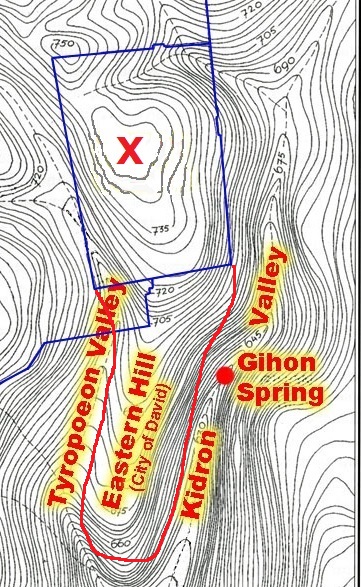
In 73 A.D., after the destruction of the Temple by the Romans in 70 A.D., Eleazar, a Jewish leader, lamented to see “the foundations of our holy temple dug up after so profane a manner.” He also stated that Jerusalem was totally destroyed except “the camp of those that hath destroyed it, which still dwells upon (over) its ruins.” (ibid., Book VII, Chap. 8, Para. 7) (emphasis added)
All that remained after 70 A.D. was the Roman fort (the camp – the Tower of Antonia). And Eleazar confirmed the prophecy of the Lord Jesus that "not one stone would be left on another." (Matthew 24:2) Today there is no remaining structural evidence of the Temple of God. It was all leveled.
It appears that the traditional Temple Mount is actually a Roman fort. Roman forts were all large rectangular structures. They contained barracks for soldiers and administrative buildings. They were all thirty to thirty-six acres in size. This, of course, describes the thirty-six acre legendary Temple Mount.
Josephus describes the interior of the Tower of Antonia:
“The inward parts had the largeness and form of a palace, it being parted into all kinds of rooms and other conveniences, such as courts, and places for bathing, and broad spaces for camps; insomuch that, by having all conveniences that cities wanted, it might seem to be composed of several cities, but by its magnificence it seemed a palace.” (Flavius Josephus, ibid., Book V, Chapter 5, Paragraph 8) (my emphasis) This sounds like the traditional Temple Mount.
Josephus describes the Roman fort in Jerusalem as being north of the Temple, and housing a legion of men. (ibid.) A Roman legion had about 6,000 soldiers, plus administrators and support personnel. This could total as many as 10,000 men, and would need a fort the size of the traditional Temple Mount.
Israeli archaeologist Dr. Eli Shukron found a coin beneath the lowest course of foundation stones in the Western Wall of the traditional Temple Mount. The coin was dated 19-20 A.D. The Western Wall is part of Herod’s expansion of the Tower of Antonia and is clearly part of the Roman fort.
On October 16, 2017, archaeologists from the Israeli Antiquities Authority discovered a Roman amphitheater adjacent to the Western Wall of the traditional Temple Mount. The archaeologists were excited to find this confirmation of Roman presence in Jerusalem.
In fact, there was a very great Roman presence. As noted above, Josephus reported that there was a Roman legion (about 6,000 men) in the Roman fort. This military presence was necessary because of the unruly and rebellious Jews. An example is found in Acts 21:30-32. The Roman commander took at least two centurions (commanders of one-hundred men) and soldiers to quell the Jewish uprising. Two centurions indicates a company of at least two-hundred men. In the following chapter, the Jews repeated their riotous performance, screaming, tearing their clothes and throwing dust into the air.
My point about the recent discovery is; Why would the Jews allow a pagan Roman theater to be built adjacent to their Holy Temple? If they rioted over the mistaken perception that Paul had brought Gentiles into the Temple (Acts 21:29), how much more would they riot over a pagan building immediately adjacent to the Temple wall?
The answer is, in my opinion, the traditional Temple Mount where the discovery was made was actually a Roman fort as described by Josephus. The Temple of God was in the City of David.
Some would argue that the Roman theater was built after the destruction of 70 A.D. when Jerusalem was rebuilt as a Roman city, Aelia Capitolina. Then, the question becomes: Why would the Romans, after destroying all indications of Jewish presence, make the exception of leaving any trace the most important of all Jewish structures, the Temple of God? It is not logical that the Romans would do so.
Remember the two immovable geographic features at Jerusalem; the Gihon Spring and the rock precipice. Josephus wrote that the Tower of Antonia was built on a fifty cubit (seventy-five foot) high precipice. This describes the traditional Temple Mount. It is the only rock precipice in the area.
Consideration of the seventy-five foot high rock precipice also destroys the idea that this was the location of the threshing floor of Ornan the Jebusite. This rock precipice was not level until it was walled about, filled with earth and paving stones were used to create a platform. A rock precipice is not a satisfactory location for a threshing floor.
Byzantine Presence on the Legendary Temple Mount
Historic documents from the Fourth and Fifth Centuries describe Byzantine churches built on the site of the Roman fort, now known as the traditional Temple Mount. This was before the Muslim capture of Jerusalem in 636-637 A.D. One church was built at the southern end, where the Al-Aqsa mosque is now. The second church was built where they thought the location of Pilate's praetorium was, in order to honor the place where the Lord Jesus was condemned to die. The Byzantines built churches on any site thought to have been visited by the Lord Jesus, or of any Christian significance. The octagonal Muslim Dome of the Rock occupies this second location today. Is it not ironic that the Dome of the Rock honors and protects the very place where the Lord of Glory was condemned?
Repairs to the Al-Aqsa mosque were necessary because of an earthquake in 1927. The repairs took years. In the process, the immense wooden beams were tested for origin and age. They were found to be cypress and cedars from Lebanon. And they were dated to the time of the First and Second Temples! Some of the huge wooden beams were from the time of Solomon's Temple! The Bible tells us that King Hiram of Tyre provided the cedar for the Temple. (I Chronicles 22:4) It is not a great leap of logic to suggest that the Byzantine church at that location was built using the timbers from the destroyed Jewish Temple; and the Al-Aqsa mosque is a converted Christian church.
R. W. Hamilton, the Director of the British Mandate Antiquities Department at the time of the Al-Aqsa repairs, recorded the many discoveries in a document of over three-hundred pages. One of the discoveries was a mosaic floor beneath the mosque. The mosaic pattern was photographed and included in the report.
In November 1999 the Muslim Waqf began an unauthorized work on the traditional Temple Mount. They dumped an estimated three-hundred, fifty truckloads of dirt and debris into the Kidron valley. In 2004 archaeologists Gabriel Barkay and Zachi Dvira began the Temple Mount Sifting Project to recover artifacts from the spoil dumped by the Muslims. In 2008 Dr. Zachi Dvira found R. W. Hamilton's report on the Al-Aqsa repairs in the archives of the Israeli Antiquites Authority. Dr. Divra noted that the mosaic flooring found beneath the Al-Aqsa mosque was almost exactly the same as a mosaic floor in the Byzantine Church of the Nativity in Bethlehem. There was a Byzantine presence on the legendary Temple Mount. In fact, Dr. Divra knew this because of the hundreds, if not thousands, of Byzantine artifacts from the legendary Temple Mount found by the Sifting Project.
The church built over the site of Pilate's praetorium was an octagonal building. The Byzantines built numerous octagonal churches including One over the traditional site of Peter's home in Capernaum, and the Church of the Holy Sepulcher which is just a few hundred feet west of the legendary Temple Mount. It seems clear that the octagonal Dome of the Rock was built on the foundations of the original Byzantine church.
As an aside, the Bordeaux Pilgrim (333 A.D.) recorded that when he climbed the tower of the Church of the Holy Sepulcher and looked east, he saw the walls of the Roman fort!
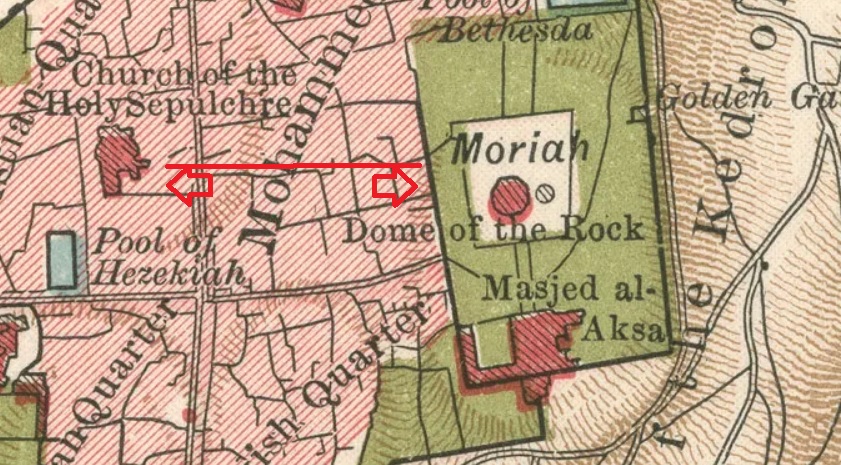
The Ancient Worship Site
In December 2011 Israeli archaeologist Dr. Eli Shukron unearthed a site beneath the City of David. This place is approximately thirty feet of the Gihon Spring. This is important because of the association of the Gihon Spring with the Temple of God. Please note how this archaeological site is carved into the bedrock of the City of David.
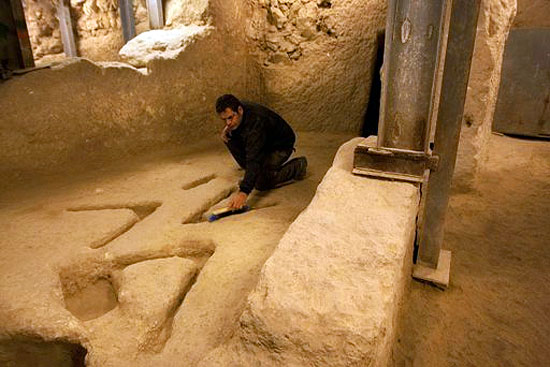
Dr. Shukron believes this site dates back to the time when Melchizedek, king of Salem (later known as Jerusalem) and priest of God Most High, met Abram. (Genesis 14:18-20) It is no stretch of the imagination that Melchizedek may have worshipped the Lord in this very spot.
When Jacob fled his home in Beersheba, he slept in or near a town named Luz. That night he had a dream of angels ascending and descending a ladder or stairway from Heaven. Jacob determined that this place was the House of God and named it Beth El, which means "House of God." Jacob took the stone that he had used as a pillow and made it an upright pillar. He sanctified the pillar by anointing it with oil. (Genesis 28:18-19)
In this site in the City of David was found a natural stone pillar much like the one Jacob erected at Beth El. Because the pillar of Jacob has never been found, it is possible that this is the very stone. The pillar had been placed securely in a base of twelve stones, presumably representing the Twelve Tribes of Israel. Dr. Shukron placed a locked steel box over the pillar to protect it since this was not just a random rock found at this ancient worship site.
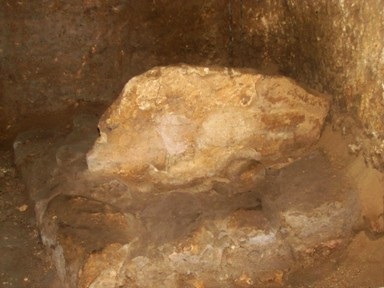
In order to confirm whether or not the rock pillar found in the City of David excavation might be the same as that erected by Jacob, I have tried to show through Scripture that Bethel and the City of David/Jerusalem are really the same place. But it will not work. In the list of cities given to the Tribe of Benjamin in the Book of Joshua, both Bethel and Jerusalem are found, so it appears they cannot be the same place.
“Now the cities of the tribe of the children of Benjamin according to their families were Jericho, and Bethhoglah, and the valley of Keziz, And Betharabah, and Zemaraim, and Bethel, . . . And Zelah, Eleph, and Jebusi, which is Jerusalem . . .” – Joshua 18:21-28 (my emphasis)
Even though Bethel and Jerusalem are two separate locations, that does not totally eliminate the rock pillar found in the special worship site from being the same rock pillar that Jacob erected. Bethel became the center of worship of the Golden Calf set up by Jereboam.(I Kings 12:28-29) It is possible that Solomon was fore-warned by the Lord and the Pillar of Jacob was moved from what would become a pagan site. Solomon may have moved this stone to the City of David, to the location where the Lord chose to place His name. The Prophet Amos foretold that "Bethel shall come to nought." (Amos 5:4-5) For this reason the pillar may have been moved the few miles between the two cities.
A study of the Hebrew word matzebah (Strong’s H4676) confirms, I believe, the age of this recent discovery. The word matzebah is first found in the account of Jacob’s dream of angels ascending and descending a ladder or staircase. (Genesis 28:10-22) This word matzebah continues in use in the Old Testament, but after the time of Moses it is used only in describing pagan images. The Lord instructed the Children of Israel to break down the pagan, graven images (matzebah) in Exodus 23:24, while they were still at Mount Sinai. The point is that by the time the Children of Israel returned to the Promised Land, pillars, or matzebahs, were not used. Abraham and Jacob both lived before the time of Moses and the Law, which confirms the ancient dating of this site.
Scripture gives us one more indication of the importance of this site. When King David was dying, he instructed that Solomon be taken down to the Gihon Spring to be anointed king. I wonder if, through the inspiration of the Holy Spirit, the Gihon spring was noted rather than the Holy Worship site in order to obscure knowledge of the worship site until a future time. David's instructions would have naturally included the worship site. Remember, the Gihon Spring is only thirty feet away. In addition to the worship site, apparently the Tabernacle erected by King David was there also. Zadok the priest took a horn of oil from the Tabernacle to anoint Solomon king of Israel (1 Kings 1:32-40), so the Tabernacle must have been nearby. How appropriate was it that Solomon should be anointed king at this very place.
Adjacent to this pillar is an olive press for making olive oil. This press is small and was probably used for sacred purposes, unlike larger “commercial” olive presses. I believe this olive press was only for the purpose of making oil to anoint the pillar.
The archaeologists are convinced that the pillar, or matzebah, is of Hebrew origin, and not from the pagan Jebusites who lived here before King David conquered the city.
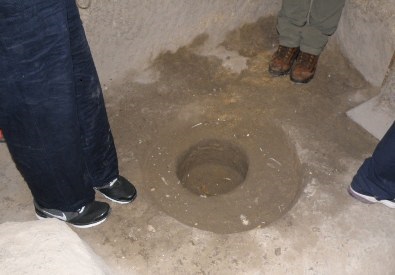
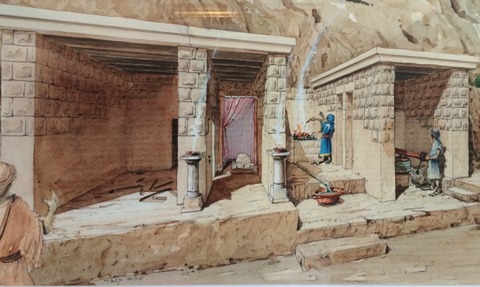
Why This Worship Site is Underground
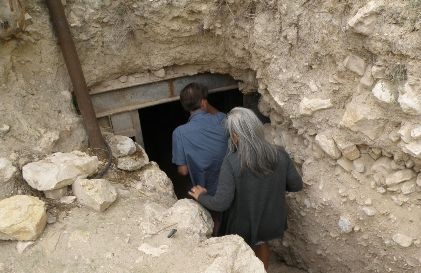
When I first realized the importance of this archaeological site, it troubled me that it was underground. I did not, and do not, think that a place sacred to the Lord would be underground. But when the Lord directed the placement of this sacred site, it was not underground!
Josephus, one of our best historical sources of information about Jerusalem, says that because of the size of the threshing floor of Ornan the Jebusite, Solomon built a wall to the east which ultimately resulted in “a large plain” or plaza. (Flavius Josephus, Wars of the Jews, Book V, Chapter 5, Paragraph 1) Later, Josephus describes the wall as being compassed about by a deep valley. (Flavius Josephus, Antiquities of the Jews, Book XV, Chapter 11 Paragraph 3) He also reported that the eastern cloisters were “situated in a deep valley.” (ibid. Book XX, Chapter 9, Paragraph 7) Remember, Josephus was there. He saw the Temple with his own eyes. He is not repeating something that he heard or read.
The Josippon, a later Jewish history, states that the eastern foundation wall of the Temple came to within a cubit, or about eighteen inches, of the Brook Kidron. Josephus said that the Temple walls were so high that you got "giddy" looking down. (ibid. Book XV, Chapter 11 Paragraph 5)
Nehemiah seems to confirm this extended eastern wall. He walked up the bed of the Brook Kidron to inspect the wall, which must have been right beside the brook, confirming the statements of Josephus and the Josippon. (Nehemiah 2:15) Three times in the next chapter, Nehemiah refers to the “tower which lieth out.” (Nehemiah 3:25-27) There was a tower, or wall, on the east side of Jerusalem which extended beyond the other city walls.
Therefore, the "eastern cloister," or eastern wall, of the Temple of Solomon was situated right beside the Brook Kidron, which today is the Kidron Valley.
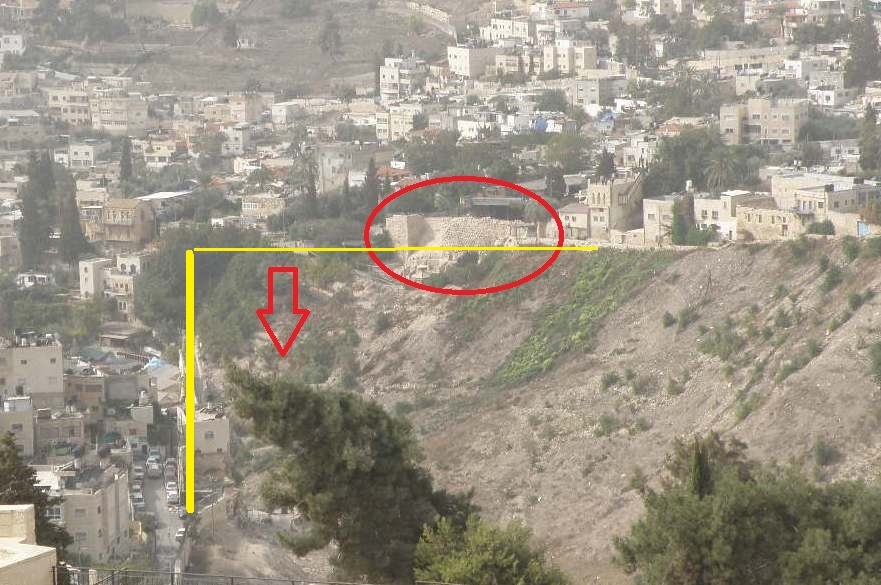
The photograph above was taken from the Mount of Olives. On the left is the Kidron valley, now filled in with the rubble of destruction and centuries of erosion and dust storms. Circled on top of the hill is the “stepped stone structure,” thought to be an ancient retaining wall, and indicating the ground level of the City of David. The building to the right of the circle is the City of David Museum. The arrow points to the location of the worship site found underground. The Gihon Spring is adjacent to this area.
This photo illustrates the description of Josephus:
"... for when he [Solomon] had filled up great valleys with earth, which, on account of their immense depth, could not be looked on when you bended down to see them, without pain, and had elevated the ground four hundred cubits [600 feet], he made it to be on a level with the top of the mountain, on which the temple was built." (Flavius Josephus, Antiquities of the Jews, Book VIII, Chapter 3, Paragraph 9 - author's emphasis)
And again from Josephus:
"... for they brought earth, and filled up the valleys, as being desirous to make them on a level with the narrow streets of
the city." (Flavius Josephus, Wars of the Jews, Book V, Chapter 5, Paragraph 1)
The eastern wall of the Temple plaza (vertical yellow line) was so high that you got dizzy just looking down over it. It was adjacent to the Kidron valley and you can see how much fill would be required to bring the ground up to the level of the City of David (horizontal yellow line). It is easy to see how the worship site was buried. Dr. Shukron reports that it was carefully buried. It was filled with layers of dirt and gravel to provide a stable foundation for the plaza built above it. And again, how appropriate was it that Solomon, having been anointed king in this very location, should have carefully covered this holy place to erect the Temple of God above it in the City of David.
I believe this holy site was chosen at the direction of the Lord. Because it was to be buried, it escaped any notice of the Babylonian or Roman soldiers who were told to destroy the Temple and the city.
Remember, the City of David was originally only about twelve acres in size. This wall would have caused any structures on the east side of the hill of the City of David to be buried. This would include the fortifications around the Gihon Spring and the special site where God was worshipped .
This explains why in 1995 Ronny Reich and Eli Shukron found the Spring House, a fortification of the Gihon Spring, underground. It, too, was buried with the fill for the Temple plaza. What other reason could there be for burying a natural spring?
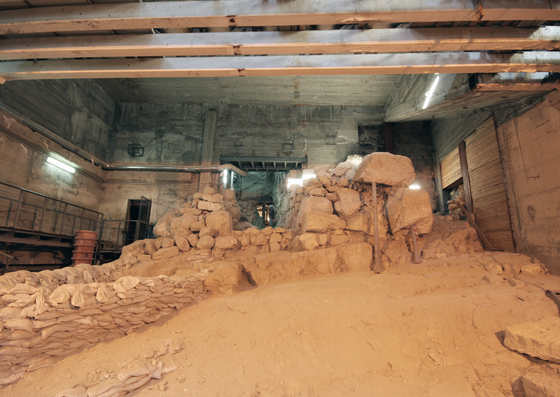
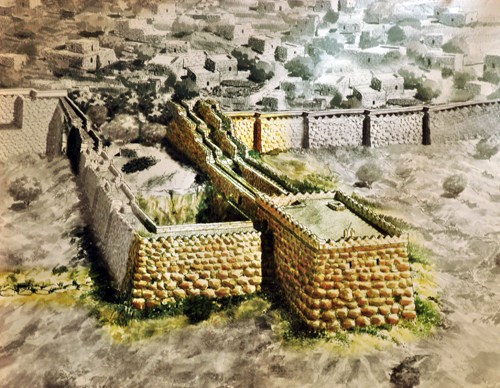
The House of God Symbols
Also, within this special place uncovered by Dr. Shukron are symbols, several feet wide, carved or engraved deeply in the bedrock floor of the site. These symbols have mystified archaeologists since they were discovered.
When the markings were discovered, the Ir David Foundation, operators of the City of David Museum, asked for the public to give suggestions as to what they meant. The foundation received over 20,000 responses; some serious, others whimsical, others still were ridiculous (e.g. – foot prints of King Solomon’s pet dinosaur).
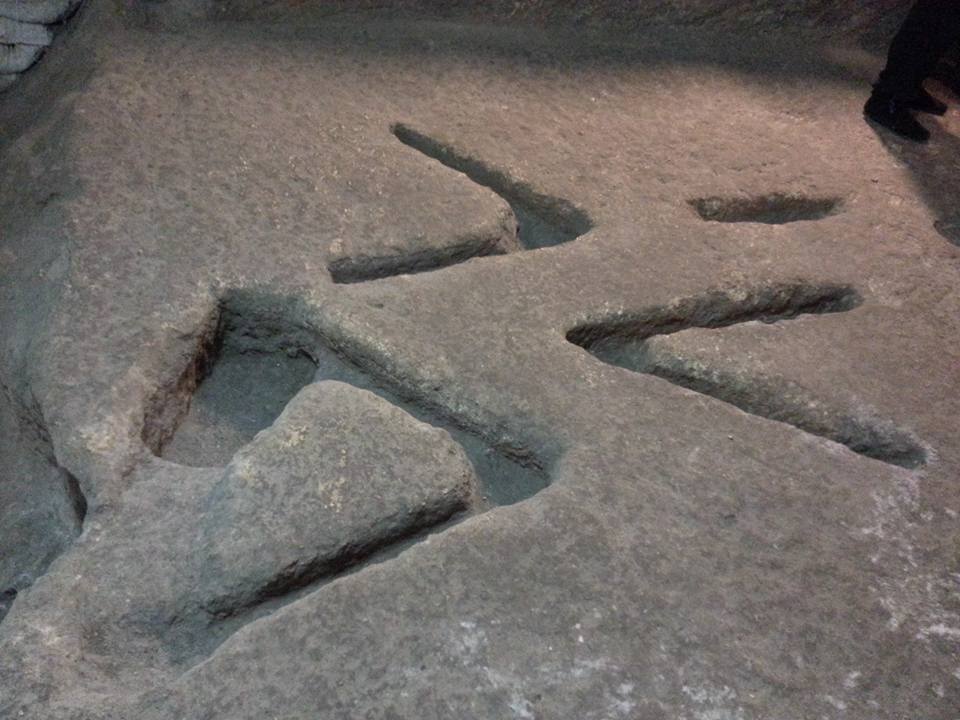
My wife and I were blessed to be able to visit this very special archaeological site in 2015. It is believed that the “mysterious markings” in the bedrock floor of the site were, in fact, ancient Hebrew letters.
Below are two examples of the Hebrew letter “Beit.” The left beit is from the time of Moses. The one of the right is from the inscription found in Hezekiah’s Tunnel, which was used to channel the water from the Gihon Spring. The tunnel inscription is mere feet from the special archaeological site.
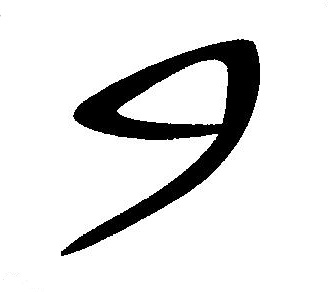
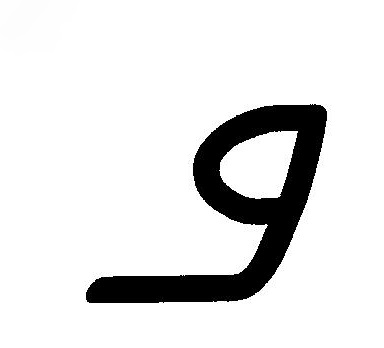

Here is the Paleo-Hebrew beit, compared with the letter found carved in the floor.
It appears that this “symbol” is the letter beit, which in Hebrew means “house.”
The next group of “symbols” is more difficult. It is believed that together they represent the Hebrew letter “yod,” which corresponds to our English letter “J.” Here are some examples of Paleo-Hebrew yods. The yod on the left is from early Hebrew writings. The one on the right again is from Hezekiah’s Tunnel.
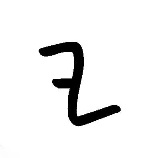


Here is the Paleo-Hebrew yod, inverted, and compared with the letter found carved in the floor.
The Hebrew yod is the first letter in the name of God, JHVH, translated as LORD in the King James Version. When we say “Hallelujah” we are saying “Praise God.” Jah is a contraction of the tetragrammaton, JHVH, pronounced “Jehovah” in English, and is not just a title like el, but is God’s name. The name Jah is found forty-nine times in the Old Testament. With the exception of Psalm 68:4, it is translated as “LORD” in the King James Version. This is all in capital letters to differentiate it from “Lord,” a title of deference used in addressing men. It is LORD, representing the name of the Lord God Jehovah.
In Hebrew, beit means “house.” The yod is the first letter of the name of God, JHVH. The Beit Yod together say, in my opinion, House of JHVH (God).
This opinion on the markings was later confirmed as correct by Dr. William Welty, who specializes in ancient languages and has translated Hebrew and Greek texts for the International Standard Version (ISV) of the Bible.
The letter “beit” facing east, and the letter “yod” facing west, is an indication that the House of God extends from the east to the west, an infinite distance, just as the Lord removes our transgressions “as far as the east is from the west.” (Psalm 103:12)
In Israel today there is Bethel (House of God), about ten miles north of Jerusalem, and named by Jacob. The name is composed of two Hebrew words, beit meaning house and el meaning “god.” But el is a title, not a name, and is used many times in the Bible in reference to many beings, not just the Lord God. And now, another location has been found, inscribed beit jod, or House of JHVH. What is the difference?
The difference, quite simply, is that Bethel (beit el - House of God) was named by a man, Jacob. The markings found in the City of David (beit jah - House of God, or House of JHVH) were placed there by the instruction of the Most High God Himself because this was the place He chose, as He stated in Scripture. It is possible that the Lord inscribed the letters with His own hand, just as He inscribed the Ten Commandments on the stone tablets. Is it not exciting to see the name of God, possibly inscribed by His own hand!
Further, as noted before, el is not a name, but a title used many times for other entities besides the Lord God. I believe the markings found in the City of David are there at the design and intent of the Lord. The City of David, and specifically the ancient worship site where Solomon was anointed king of Israel, is the place the Lord chose for His name.
As much as 4,000 years ago, this sacred place of worship was cut out of the bedrock of the City of David and in a location specified, I believe, by the Lord. The Lord knew that at a future time this place of worship, marked “House of God,” would be covered when the City of David was expanded for the building of the Temple. I believe the Lord was holding this sacred place “in readiness” for a future generation. I strongly suspect that He had this current generation in mind.
In addition, the archaeological site, this place of worship, discovered by Dr. Shukron includes symbols of the “Godhead” or “Trinity.”

I believe this special place with the ancient stone pillar, the olive press and Hebrew letters marking it as the House of God is indeed a holy place. I believe it is a sacred place, hidden purposefully to be a confirmation of holy ground in a future time. I believe it marks the location of the House of God known as the Temple. I believe the Temple was built above this precious and holy site, and above the adjacent Gihon Spring.
This fantastic discovery was made eleven years ago in 2011, and yet it has received little or no notice. Part of the reason is the inertia of tradition. The traditional Temple Mount has been thought to be the location of the Temple for such a long time. Until the legendary Temple Mount is not worshipped, it will be difficult to overcome the inertia.
Another reason for the lack of notice may be from the Lord Himself. The Lord said that He would choose the place. The Lord revealed this place to David and Solomon. (I Kings 8:29) And having identified the place for His name, the place is holy unto Him.
Perhaps the Lord is not ready for His sacred site to become known. Perhaps the Lord does not want the hatred, strife and commotion that is occurring at the legendary Temple Mount to take place at a site He considers sacred and holy.
I present this astounding discovery because there are Brothers and Sisters in Christ who will be amazed and blessed just as I was. The Lord blessed me with this discovery, and I pray it will be a blessing to those who can receive it, and are not affected by the blinders of tradition.
We know that a temple, or tabernacle, will be built during the time we call "the Tribulation." (II Thessalonians 2:4) Because of the actions of evil men, and because the representative of Satan will sit in this dedicated place, the Lord may not want it to be built on the place He chose for His name. For this reason, and for the reason of tradition, the Tribulation temple may not be built in the City of David.
One thing is certain. When the Lord chooses at His appropriate time, this sacred site denoted as the House of God will become known. The Temple of God will be built over it, as before. In my opinion, this will be during the Millennial Kingdom when the Lord Jesus, as King of kings and Lord of lords, will reign. Praise His name! If I am wrong, the Lord will confirm the location wherever He determines. May His will be done.
I personally feel very sure that the archaeological site found by Dr. Eli Shukron is a very special, holy, sacred place. I would not be surprised if Abraham and Melchizedek worshipped there. Scripture tells us that Solomon was anointed king in this location. I believe it is the location of the House of God and it marks the location, that is the City of David, of the original Temple of Solomon. What a privilege and blessing to have stood in that very place!